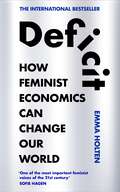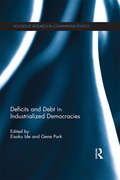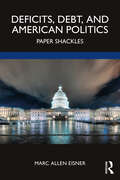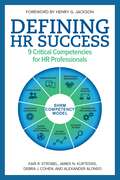- Table View
- List View
Deferred Taxes at Obadiah Vineyard
by Romana L. AutreyObadiah Vineyard's owners create financial statements in accordance with generally accepted accounting principles (GAAP) to help them obtain funding to plant more acreage. The owners grapple with deferred taxes and the differences between tax and financial reporting books.
Defiance of the Patriots
by Benjamin L. CarpOn the evening of December 16, 1773, a group of disguised Bostonians boarded three merchant ships and dumped more than forty-six tons of tea into Boston Harbor. The Boston Tea Party, as it later came to be known, was an audacious and revolutionary act. It set the stage for war and cemented certain values in the American psyche that many still cherish today. But why did the Tea Party happen? Whom did it involve? What did it mean? The answers to these questions are far from straightforward. In this thrilling new book, Benjamin L. Carp tells the full story of the Tea Party--exploding myths, exploring the unique city life of Boston, and setting this extraordinary event in a global context for the first time. Bringing vividly to life the diverse array of people and places that the Tea Party brought together--from Chinese tea-pickers to English businessmen, Native American tribes, sugar plantation slaves, and Boston's ladies of leisure--Carp illuminates how a determined group shook the foundations of a mighty empire, and what this has meant for Americans since. As he reveals many little-known historical facts and considers the Tea Party's uncertain legacy, he presents a compelling and expansive history of an iconic event in America's tempestuous past.
Defiant Braceros: How Migrant Workers Fought for Racial, Sexual, and Political Freedom (The david J. Weber Series In The New Borderlands History Ser.)
by Mireya LozaIn this book, the author sheds new light on the private lives of migrant men who participated in the Bracero Program (1942-1964), a binational agreement between the United States and Mexico that allowed hundreds of thousands of Mexican workers to enter this country on temporary work permits. While this program and the issue of temporary workers have long been politicized on both sides of the border, the author argues that the prevailing romanticized image of braceros as a family-oriented, productive, legal workforce has obscured the real, diverse experiences of the workers themselves. Focusing on underexplored aspects of workers' lives--such as their transnational union-organizing efforts, the sexual economies of both hetero and queer workers, and the ethno-racial boundaries among Mexican indigenous braceros--author reveals how these men defied perceived political, sexual, and racial norms. Basing her work on an archive of more than 800 oral histories from the United States and Mexico, the author is the first scholar to carefully differentiate between the experiences of mestizo guest workers and the many Mixtec, Zapotec, Purhepecha, and Mayan laborers. In doing so, she captures the myriad ways these defiant workers responded to the intense discrimination and exploitation of an unjust system that still persists today.
Deficit Delusion: Why Everything Left, Right, and Supply-Side Tells You About the National Debt Is Wrong
by John TamnyThere&’s a growing consensus about the causes of budget deficits and the national debt. And that&’s the problem. At present, members of the Left claim that higher rates of taxation levied on the rich are the fix, members of the Right call for a combination of spending cuts, tax increases and entitlement reform, while supply siders confidently assert that the path out of debt is tax cuts that will shower the Treasury with higher tax revenues borne of soaring economic growth. The solutions flamboyantly mistake the problem. In his latest and arguably most pathbreaking book, Parkview Institute president John Tamny asks readers to contemplate government debt in an all-new way, and in doing so makes a powerful case that deficits and the national debt will continue to grow precisely because left, right and supply side profoundly misunderstand why there&’s debt in the first place. While the warring ideologies promote what they imagine are different solutions to the perceived debt problem, it&’s lost on them that they&’re basically saying the same thing: an insufficiency of federal tax revenue has resulted in deficits and debt that seemingly soar without endpoint. Tamny makes a case that the arguments fail repeatedly precisely because they&’re backwards. Drawing on examples from private individuals and businesses, Tamny turns the debt discussion on its head. Far from a signal of insufficient revenue, Tamny shows that government debt is a logical and perilous effect of market optimism about rising tax revenues now, and much more dangerous, the expectation of exponentially more tax revenue in the future. Readers of The Deficit Delusion will gradually see the folly of a deficit and debt discussion that has grown stale and terribly confused, all the while looking at the Reagan tax cuts, skyrocketing government debt in California, entitlement reform, and the soaring national debt through an entirely different lens. Far from an apology for all the government debt, Tamny makes a passionate case that the debt crisis is not what the alarmists of the competing ideologies imagine it to be, but is instead one of soaring tax revenue itself that, if unchecked, will render the national debt of the moment rather pedestrian in comparison to what&’s ahead. For far too long readers have been inundated with the same arguments and same solutions dressed up differently to feed the differing views of the competing ideologies. With The Deficit Delusion, readers finally have a book that will prove the mask-off moment for left, right and supply side.
Deficit Politics in the United States: Taxes, Spending and Fiscal Disconnect (Europa Economic Perspectives)
by Dennis S IppolitoFrom the clashes between Federalists and Republicans in the 1790s until today, partisan battles over taxing, spending, and public debt have shaped American political development. These battles were formerly constrained by fiscal norms that mandated balanced budgets and low debt. In his Farewell Address, President George Washington counseled the nation to "cherish public credit" by using "it as sparingly as possible". In the 1980s, however, tax cuts and spending increases created large structural deficits and much higher debt levels. With only a brief interruption in the late 1990s, deficit politics has been a mainstay ever since. Over this period, the Republican Party has passed large tax cuts but failed to retrench the large entitlement programs that continue to raise spending. Likewise, the Democratic Party has expanded the domestic role of government but has abandoned the broad-based taxation it supported in the 1990s. Funding their domestic agenda with matching revenues is now as unappealing for Democrats as entitlement cutbacks are for Republicans, contributing to the current stalemate of Republican tax policy, Democratic spending policy, and soaring deficits and debt. The economic risks this entails are serious, yet an end to the era of deficit politics is nowhere in sight.
Deficit: How Feminist Economics Can Change Our World
by Emma Holten*AN INTERNATIONAL BESTSELLER*WINNER OF THE POLITIKEN LITERATURE PRIZE 2024'Brilliantly rewrites the history of economic thought to place 'her story' at its heart. A must-read' - Kate Raworth, author of DOUGHNUT ECONOMICS'One of the most important feminist voices of the 21st century . . . The book about capitalism we didn't know we needed' - Sofie HagenIn 2020, the prominent Danish feminist Emma Holten read an article stating that women were a net ‘deficit’ to society. Women took more than they gave, ‘draining’ the public purse by giving birth and taking parental leave. They contributed less than their fair share in taxes, because they often worked part-time to look after other people at home, or held low-paidjobs in the public sector. Denmark would be richer if women’s lives looked more like men’s, the economic experts concluded. A similar story is told around the globe.How did we get here? In Deficit, Emma Holten traces how economic thinkers – from the Enlightenment onwards – created a value framework that overlooked and neglected ‘women’s work’ and acts of care. She reveals how the economic models that drive political decisions today are just as flawed, giving us unparalleled monetary wealth, but causing deep social harms that are hurting us all.If we cannot properly value the things that matter, how can we build a better future?
Deficits and Debt in Industrialized Democracies (Routledge Research in Comparative Politics)
by Gene Park Eisaku IdeSince the global financial crisis, government debt has soared globally by 40 percent and now exceeds an astonishing $100 trillion. Not all countries, though, have fared the same. Indeed, even prior to the financial crisis, the fiscal fates of countries have been diverging, despite predictions that pressures from economic globalization push countries toward more convergent fiscally conservative policies. Featuring the work of an international interdisciplinary team of scholars, this volume explains patterns of fiscal performance (persistent patterns of budget deficits and government debt) from the 1970s to the present across seven countries – France, Italy, Germany, Japan, South Korea, Sweden, and the United States. Employing a comparative case study approach, seldom employed in studies of fiscal performance, contributions illuminate the complex causal factors often overlooked by quantitative studies and advances our theoretical understanding of fiscal performance. Among other things, the cases highlight the role of taxpayer consent, tax structure, the welfare state, organization of interests, and labor and financial markets in shaping fiscal outcomes. A necessary resource to understand a broader array of factors that shape fiscal outcomes in specific national contexts, this book will reinvigorate the study of fiscal performance.
Deficits, Debt, and American Politics: Paper Shackles
by Marc Allen EisnerFor most of the nation’s history, periods of growing indebtedness in the United States—a product of wars and economic crises—were followed by reductions in the debt-to-GDP ratio. But why have the last several decades failed to follow this pattern, leaving the national debt at its highest level since World War II? In this groundbreaking new book, author Marc Allen Eisner, who has devoted most of his scholarly career to studying the evolution of the US political economy, explores the significant changes in the fiscal conditions of the United States during the postwar period, embedding the discussion in a broader historical context. He demonstrates that the national debt is in part a product of reduced revenues and the growing costs of the largest entitlement programs, but it also reflects a long series of shocks, including two wars, the financial crisis and Great Recession, and the COVID-19 pandemic. Deficits, Debt, and American Politics chronicles the history of the US debt in the postwar period, placed in the context of broader changes in the political economy and partisan politics. But it grounds this exploration in reader-friendly, chapter-length discussions of public finance, taxation, mandatory spending, and the budgetary process from a policy perspective. The volume concludes with a discussion of the challenges of comprehensive tax and program reform in the current political climate. Deficits, Debt, and American Politics assumes little prior knowledge on the part of the reader, making it an ideal book for courses on public policy and political economy taught at both the upper-level undergraduate and graduate level. The material on public finance, long-term trends in taxation and spending, and the budgetary process, often relegated to descriptive texts, will be invaluable in courses engaging the deficit and debt.
Deficits, Debt, and American Politics: Paper Shackles
by Marc Allen Eisner"For most of the history of the United States, periods of growing indebtedness—a product of wars and economic crises—were followed by reductions in the debt-to-GDP ratio." But why have the last several decades failed to follow this pattern, leaving the national debt at its highest level since World War II? In this groundbreaking new book, author Marc Allen Eisner, who has devoted most of his scholarly career to studying the evolution of the US political economy, explores the significant changes in the fiscal conditions of the United States during the postwar period, embedding the discussion in a broader historical context. He demonstrates that the national debt is in part a product of reduced revenues and the growing costs of the largest entitlement programs, but it also reflects a long series of shocks, including two wars, the financial crisis and Great Recession, and the COVID-19 pandemic. Deficits, Debt, and American Politics chronicles the history of the US debt in the postwar period, placed in the context of broader changes in the political economy and partisan politics. But it grounds this exploration in reader-friendly, chapter-length discussions of public finance, taxation, mandatory spending, and the budgetary process from a policy perspective. The volume concludes with a discussion of the challenges of comprehensive tax and program reforms in the current political climate.Deficits, Debt, and American Politics assumes little prior knowledge on the part of the reader, making it an ideal book for courses on public policy and political economy taught at both the upper-level undergraduate and graduate level. The material on public finance, long-term trends in taxation and spending, and the budgetary process, often relegated to descriptive texts, will be invaluable in courses engaging the deficit and debt.
Deficits, Debt, and the New Politics of Tax Policy
by Dennis S. IppolitoThe Constitution grants Congress the power 'to lay and collect taxes, duties, imposts and excises'. From the First Congress until today, conflicts over the size, role and taxing power of government have been at the heart of national politics. This book provides a comprehensive historical account of US tax policy that emphasizes the relationship between taxes and other budget components. It explains how wars, changing conceptions of the domestic role of government, and beliefs about deficits and debt have shaped the modern tax system. The contemporary focus of this book is the partisan battle over budget policy that began in the 1960s and triggered the disconnect between taxes and spending that has plagued the budget ever since. With the US government now facing its most serious deficit and debt challenge in the modern era, partisan debate over taxation is almost completely divorced from fiscal realities.
Define Broad and Simple Rules: One Path to Executing the "Workforce of One" Approach to People Management
by Susan Cantrell David Y. SmithWhen it comes to crafting HR practices that are highly relevant and tailored to individuals, organizations can choose one of four different approaches to what talent management experts Susan Cantrell and David Smith call the "workforce of one." But no matter which approach you choose, the goal is the same: work that is sculpted to fit lives instead of lives that are sculpted to fit work. The reward? Lower employee turnover, greater productivity, and improved profit margins. In this chapter, the authors explore defining broad and simple rules to guide employees toward a desired outcome. This approach allows individuals or their managers to customize people practices by giving them structured freedom-essentially "widening the guardrails" along the route to achieving company goals. This is by no means a laissez-faire approach: workers' freedom is constrained by clear, organizationally determined and approved boundaries and limits. These could be based on the organization's mission and strategy, its values, its resources and budgetary restrictions, or its benchmarks for success. Using rich examples from companies like American Airlines, The Container Store, Best Buy, and Google, the authors show how broad and simple rules work in practice. The chapter concludes with recommendations for customizing your people management practices using this approach-which empowers your workforce and allows your organization to nimbly respond to changing customer needs. This chapter was originally published as Chapter 4 of "Workforce of One: Revolutionizing Talent Management Through Customization."
Define Your Operating Model: Designing a Foundation for Execution
by Jeanne W. Ross Peter Weill David C. RobertsonIn this chapter, the authors introduce the operating model as the first essential element for creating the foundation for execution. They describe four different types of operating models, using case studies of JM Family Enterprises, Merrill Lynch, Dow Chemical, TD Banknorth, and Schneider National.
Define the Future: Manage for a World of Change-Why Leading Toward the Future Is Imperative to Becoming a Great Boss
by Kent Lineback Linda A. HillDo you and the people you lead know where you're going? Have you defined a clear purpose and the goals you must achieve along the way? Do you keep your purpose and goals constantly in mind as you carry out your everyday work? Leading toward the future is a key part of being a great boss, but many bosses admit that they are simply carried along by events, allowing the pressures of today to trump the needs of tomorrow. In this chapter, authors Linda Hill and Kent Lineback explain why you, as a manager, must prepare for the future, because it will inevitably be different from today. They describe the benefits of defining where you're going-for example, it imbues your work with purpose, fosters commitment, reduces conflict, and helps you and your team deal with unforeseen change. The chapter also includes a discussion of written and unwritten plans, including easy-to-follow steps for creating a plan and a list of key questions to ask yourself in the process. The chapter concludes with a section about how you-as a great boss-can guide your group through difficult change. This chapter was originally published as Chapter 8 of "Being the Boss: The 3 Imperatives for Becoming a Great Leader."
Defined by Design: The Surprising Power of Hidden Gender, Age, and Body Bias in Everyday Products and Places
by Kathryn H. AnthonyThis wide-ranging overview of design in everyday life demonstrates how design shapes our lives in ways most of us would never imagine. The author, a leading expert in social and psychological issues in design, uncovers the gender, age, and body biases inherent in the designs of common products and living spaces that we all routinely use. From the schools our children attend and the buildings we work in to ill-fitting clothes and one-size-fits-all seating in public transportation, restaurants, and movie theaters, we are surrounded by an artificial environment that can affect our comfort, our self-image, and even our health.Anthony points out the flaws and disadvantages of certain fashions, children's toys, high-tech gadgets, packaging, public transportation, public restrooms, neighborhood layouts, classrooms, workplaces, hospitals, and more. In an increasingly diverse populace where many body types, age groups, and cultures interact, she argues that it's time our environments caught up. This fascinating book--full of aha moments--will teach readers to recognize the hidden biases in certain products and places and to work for more intelligent and healthy design in all areas of life.
Defining Aerospace Policy: Essays in Honor of Francis T. Hoban
by Julianne Lammersen-BaumFeaturing contributions from many of the most prominent contemporary figures in the US aerospace community, this book provides unprecedented insights into the ways in which aerospace policy is developed and implemented. Based on a wide range of real-life case studies and the personal experiences of those directly involved, its coverage includes some of the most influential and wide-ranging policies of modern times, including: the privatization of the Canadian air navigation system; government-industry cooperation; Leasecraft; NASA and the evolution of the hush kit; US activities to reduce launch costs; the emergence of a spaceport policy; VentureStar; issues in institutional restructuring: the problem with the FAA. Contributed in memory of Frank Hoban, the book compiles the work of a NASA funded team at George Mason University working on various institutional aspects of the aerospace policy and the aerospace industry, and also seeking out new directions for using the insights gathered from the NASA and other programs. The readership will include the management of aerospace companies and government agencies, especially in North America but also elsewhere, eg Europe (ESA), Russia and Japan. It will also include researchers and graduate students in university departments and agencies and other facilities.
Defining Democracy: Voting Procedures in Decision-Making, Elections and Governance
by Peter EmersonDefining Democracy looks both at the theory of why and the history of how different voting procedures have come to be used - or not, as the case may be - in the three fields of democratic structures: firstly, in decision-making, both in society at large and in the elected chamber; secondly, in elections to and within those chambers; and thirdly, in the various forms of governance, from no-party to multi-party and all-party, which have emerged as a result.
Defining Desired Results: Developing Results-Based Leaders
by Dave Ulrich Norm Smallwood Jack ZengerThis chapter outlines the reliable criteria leaders need to consistently pay attention to in order to attain their short- and long-term objectives, along with a set of tools to make sure that leadership attributes translate into the right results.
Defining Enterprise Data and Analytics Strategy: Pragmatic Guidance on Defining Strategy Based on Successful Digital Transformation Experience of Multiple Fortune 500 and Other Global Companies (Management for Professionals)
by Prakash SahThis is the first of its kind book that describes key elements of enterprise data and analytics strategy, and prescribes a pragmatic approach to define the strategy for large enterprises. The book is based on successful digital transformation experience of multiple Fortune 500 and other large enterprises. It is estimated that more than 50% of data and analytics initiatives fail globally because of the inherent complexity of such initiatives. Some of the questions that enterprises struggle with are: How to define enterprise data and analytics strategy? What are the key elements that should be considered while doing so? Why one-size-fits-all approach does not work for all enterprises? How to align data and analytics initiative with the business strategy of the CEO? How to establish a futuristic technology and architecture foundation, given the exponential rate of innovation in data and analytics technologies? How to define the right data and analytics organization model? Why data and analytics organization and processes need to be different from other functions? How to manage organizational change to ensure success of data and analytics initiative? How to define a business value measurement framework and calculate ROI from data and analytics initiative? What are the key skills required in a data and analytics leader to wade through political and other challenges of a large enterprise? This book will help executives, chief digital/analytics officers, data and analytics professionals, and consultants, in answering the above questions. It will help them in addressing various dilemmas that they face every day and making their enterprises data-driven.
Defining HR Success: 9 Critical Competencies for HR Professionals
by Debra J. Cohen Alexander Alonso James N. Kurtessis Kari R. StrobeToday's HR professionals are expected to be valued team members and contribute as business partners, delivering strategic value and solving complex talent challenges to achieve growth for the organization.Defining HR Success provides a deep dive into the nine core competencies that define high-performing HR practitioners:· HR Expertise (HR Knowledge)· Business acumen· Communication· Consultation· Critical evaluation· Ethical practice· Global and cultural effectiveness· Leadership and navigation· Relationship managementThe book helps readers assess their current capabilities and build the skills needed to lead and influence within their organizations. With clear explanations and practical applications, it's an essential guide for aligning HR strategy with business growth and provides HR professionals with a roadmap for personal development and professional excellence in a rapidly evolving field.
Defining Leadership Code: The Five Rules of Effective Leadership
by Dave Ulrich Norm Smallwood Kate SweetmanEveryone agrees that leadership matters. But what makes an effective leader? The answer to this simple question is elusive, but according to Ulrich, Smallwood, and Sweetman, there is actually a leadership code comprised of five rules. If you want to be a better leader or build more effective leadership in your organization, you need to master these five rules. In this chapter, the authors define the five rules of leadership and describe briefly how to make the leadership code real for you and your organization. This chapter is excerpted from "The Leadership Code: Five Rules to Lead By."
Defining Management: Business Schools, Consultants, Media
by Lars Engwall Matthias Kipping Behlül ÜsdikenDefining Management charts the expansion of management as an idea and practice from a time when it was limited to churches and households to its current ubiquity, focusing in particular on the role of business schools, consultants, and business media in this process. How did an entire industry develop around business schools, consultants, and business media who are now widely considered the authorities regarding best management practice? This book shows how these actors – on their own and in interaction – became taken-for-granted and gained such definitional power over management and managers, expanded across the globe from often modest and not always respected origins, and impacted, and continue to impact businesses and, increasingly, the broader economic and social context. Building on extant and some new research, the book is unique in bringing together issues and actors that have been examined elsewhere separately. Any student or professional of management interested in the evolution of their field or the rise of business schools, consultants and business media will find this book both novel and thought-provoking.
Defining Moments
by Joseph BadaraccoMaking decisions when there is a clear choice between "right" and "wrong" is easy. Making decisions where the choice is between "right" and "right" is not. This book lays out a series of general principles and guidelines, drawn from ancient and modern Western philosophy, which can help managers and leaders chart a course through the thickets of conflicting values and moral choices which make up all "right versus right" decisions.
Defining Moments
by Joseph L. Badaracco Jr."Defining moments," according to Badaracco, occur when managers face business problems that trigger difficult, deeply personal questions. In deciding how to act, managers reveal their inner values, test their commitment to those values, and ultimately shape their characters. Badaracco builds a framework for approaching these dilemmas around three cases of increasing complexity, reflecting the escalating responsibilities managers face as they advance in their careers. The first story presents a young man whose choice will affect him only as an individual; the second, a department head, whose decision will influence his organization; the third, a corporate executive, whose actions will have much larger, societal ramifications. To guide the decision-making process, Badaracco draws on the insights of four philosophers--Aristotle, Machiavelli, Nietzsche, and James--because they offer practical rather than theoretical advice. He thus bridges the gap between classroom philosophy and corporate pragmatism. The result is a flexible framework that managers can draw on to resolve issues of conflicting responsibility in practical ways.
Defining Moments
by Peter ShawOur lives are full of defining moments, but do we recognize them? We often fail to appreciate the significance of these moments. At work the pressure can be relentless and we can fail to enjoy these moments. The author shows how to recognize and appreciate these moments, which in turn helps us to better cope during more difficult times.
















